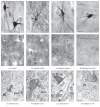Synaptic Reorganization of the Perisomatic Inhibitory Network in Hippocampi of Temporal Lobe Epileptic Patients
- PMID: 28116310
- PMCID: PMC5237728
- DOI: 10.1155/2017/7154295
Synaptic Reorganization of the Perisomatic Inhibitory Network in Hippocampi of Temporal Lobe Epileptic Patients
Abstract
GABAergic inhibition and particularly perisomatic inhibition play a crucial role in controlling the firing properties of large principal cell populations. Furthermore, GABAergic network is a key element in the therapy attempting to reduce epileptic activity. Here, we present a review showing the synaptic changes of perisomatic inhibitory neuronal subtypes in the hippocampus of temporal lobe epileptic patients, including parvalbumin- (PV-) containing and cannabinoid Type 1 (CB1) receptor-expressing (and mainly cholecystokinin-positive) perisomatic inhibitory cells, known to control hippocampal synchronies. We have examined the synaptic input of principal cells in the dentate gyrus and Cornu Ammonis region in human control and epileptic hippocampi. Perisomatic inhibitory terminals establishing symmetric synapses were found to be sprouted in the dentate gyrus. Preservation of perisomatic input was found in the Cornu Ammonis 1 and Cornu Ammonis 2 regions, as long as pyramidal cells are present. Higher density of CB1-immunostained terminals was found in the epileptic hippocampus of sclerotic patients, especially in the dentate gyrus. We concluded that both types of (PV- and GABAergic CB1-containing) perisomatic inhibitory cells are mainly preserved or showed sprouting in epileptic samples. The enhanced perisomatic inhibitory signaling may increase principal cell synchronization and contribute to generation of epileptic seizures and interictal spikes.
Conflict of interest statement
The authors declare no conflict of interests.
Figures






Similar articles
-
The epileptic human hippocampal cornu ammonis 2 region generates spontaneous interictal-like activity in vitro.Brain. 2009 Nov;132(Pt 11):3032-46. doi: 10.1093/brain/awp238. Epub 2009 Sep 18. Brain. 2009. PMID: 19767413
-
Preservation of perisomatic inhibitory input of granule cells in the epileptic human dentate gyrus.Neuroscience. 2001;108(4):587-600. doi: 10.1016/s0306-4522(01)00446-8. Neuroscience. 2001. PMID: 11738496
-
Surviving CA1 pyramidal cells receive intact perisomatic inhibitory input in the human epileptic hippocampus.Brain. 2005 Jan;128(Pt 1):138-52. doi: 10.1093/brain/awh339. Epub 2004 Nov 17. Brain. 2005. PMID: 15548550
-
[Intervention of GABAergic neurotransmission in partial epilepsies].Rev Neurol (Paris). 1997;153 Suppl 1:S46-54. Rev Neurol (Paris). 1997. PMID: 9686248 Review. French.
-
[Epileptiform activities generated in vitro by human temporal lobe tissue].Neurochirurgie. 2008 May;54(3):148-58. doi: 10.1016/j.neuchi.2008.02.004. Epub 2008 Apr 16. Neurochirurgie. 2008. PMID: 18420229 Review. French.
Cited by
-
Degeneracy in epilepsy: multiple routes to hyperexcitable brain circuits and their repair.Commun Biol. 2023 May 3;6(1):479. doi: 10.1038/s42003-023-04823-0. Commun Biol. 2023. PMID: 37137938 Free PMC article. Review.
-
Short-Term Amygdala Low-Frequency Stimulation Does not Influence Hippocampal Interneuron Changes Observed in the Pilocarpine Model of Epilepsy.Cells. 2021 Mar 1;10(3):520. doi: 10.3390/cells10030520. Cells. 2021. PMID: 33804543 Free PMC article.
-
The Subcortical-Allocortical- Neocortical continuum for the Emergence and Morphological Heterogeneity of Pyramidal Neurons in the Human Brain.Front Synaptic Neurosci. 2021 Mar 11;13:616607. doi: 10.3389/fnsyn.2021.616607. eCollection 2021. Front Synaptic Neurosci. 2021. PMID: 33776739 Free PMC article.
-
Perisomatic innervation and neurochemical features of giant pyramidal neurons in both hemispheres of the human primary motor cortex.Brain Struct Funct. 2021 Jan;226(1):281-296. doi: 10.1007/s00429-020-02182-8. Epub 2020 Dec 23. Brain Struct Funct. 2021. PMID: 33355694 Free PMC article.
-
Reduced Cholecystokinin-Expressing Interneuron Input Contributes to Disinhibition of the Hippocampal CA2 Region in a Mouse Model of Temporal Lobe Epilepsy.J Neurosci. 2023 Oct 11;43(41):6930-6949. doi: 10.1523/JNEUROSCI.2091-22.2023. Epub 2023 Aug 29. J Neurosci. 2023. PMID: 37643861 Free PMC article.
References
-
- Freund T. F., Buzsáki G. Interneurons of the hippocampus. Hippocampus. 1996;6(4):347–470. - PubMed
Publication types
MeSH terms
Substances
LinkOut - more resources
Full Text Sources
Other Literature Sources

